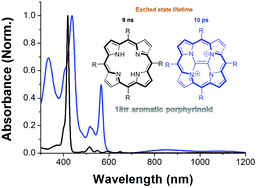The top 10 most accessed Photochemical & Photobiological Sciences articles in 2013 were as follows:
Singlet oxygen generation using a porous monolithic polymer supported photosensitizer: potential application to the photodynamic destruction of melanoma cells
M. Isabel Burguete, Francisco Galindo, Raquel Gavara, Santiago V. Luis, Miguel Moreno, Paul Thomas and David A. Russell
Photochem. Photobiol. Sci., 2009,8, 37-44, DOI: 10.1039/B810921D, Paper
Light relief: photochemistry and medicine
David Phillips
Photochem. Photobiol. Sci., 2010,9, 1589-1596, DOI: 10.1039/C0PP00237B, Perspective
From themed collection Photosciences: a look into the future
UV-induced DNA damage and repair: a review
Rajeshwar P. Sinha and Donat-P. Häder
Photochem. Photobiol. Sci., 2002,1, 225-236, DOI: 10.1039/B201230H, Perspective
On the genesis of heterogeneous photocatalysis: a brief historical perspective in the period 1910 to the mid-1980s
N. Serpone, A. V. Emeline, S. Horikoshi, V. N. Kuznetsov and V. K. Ryabchuk
Photochem. Photobiol. Sci., 2012,11, 1121-1150, DOI: 10.1039/C2PP25026H, Perspective
Photoinduced formation of reversible dye radicals and their impact on super-resolution imaging
Sebastian van de Linde, Ivan Krstić, Thomas Prisner, Sören Doose, Mike Heilemann and Markus Sauer
Photochem. Photobiol. Sci., 2011,10, 499-506, DOI: 10.1039/C0PP00317D, Paper
Engineered photoreceptors as novel optogenetic tools
Andreas Möglich and Keith Moffat
Photochem. Photobiol. Sci., 2010,9, 1286-1300, DOI: 10.1039/C0PP00167H, Perspective
From themed collection Photofunctional proteins: from understanding to engineering
Signaling mechanisms of LOV domains: new insights from molecular dynamics studies
Peter L. Freddolino, Kevin H. Gardner and Klaus Schulten
Photochem. Photobiol. Sci., 2013,12, 1158-1170, DOI: 10.1039/C3PP25400C, Paper
From themed collection Blue-light photoreceptors
Photoremovable protecting groups: reaction mechanisms and applications
Anna Paola Pelliccioli and Jakob Wirz
Photochem. Photobiol. Sci., 2002,1, 441-458, DOI: 10.1039/B200777K, Perspective
Human safety review of “nano” titanium dioxide and zinc oxide
Karsten Schilling, Bobbie Bradford, Dominique Castelli, Eric Dufour, J. Frank Nash, Wolfgang Pape, Stefan Schulte, Ian Tooley, Jeroen van den Bosch and Florian Schellauf
Photochem. Photobiol. Sci., 2010,9, 495-509, DOI: 10.1039/B9PP00180H, Perspective
From themed collection Topical and systemic photoprotection
Time-resolved fluorescence microscopy
Klaus Suhling, Paul M. W. French and David Phillips
Photochem. Photobiol. Sci., 2005,4, 13-22, DOI: 10.1039/B412924P, Perspective
From themed collection In honour of Hiroshi Masuhara
Take a look at the articles, and then let us know your thoughts and comments below.
If you are interested in submitting your own work to Photochemical & Photochemical Sciences, you can submit online today, or email us with your ideas and suggestions. Journal guidelines are available on the website.
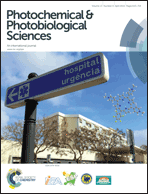











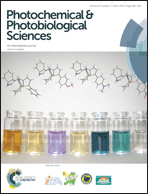 The front cover this month features work by Carlos Lodeiro and co-workers from Lisbon, Portugal. In their work report the synthesis of bis(indolyl)methane derivatives bearing functionalized arylthiophene spacers, and explore their solvatochromic behaviour in the ground and excited states.
The front cover this month features work by Carlos Lodeiro and co-workers from Lisbon, Portugal. In their work report the synthesis of bis(indolyl)methane derivatives bearing functionalized arylthiophene spacers, and explore their solvatochromic behaviour in the ground and excited states.
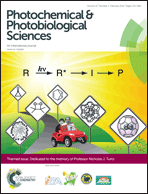 Dedicated to the memory of Nicholas J. Turro, late Professor of Chemistry at Columbia University, this issue presents a collection of articles from scientists either directly or indirectly associated with his laboratory. The collection reflects both the geographic diversity and breadth of scientific interests of those connected with Professor Turro .
Dedicated to the memory of Nicholas J. Turro, late Professor of Chemistry at Columbia University, this issue presents a collection of articles from scientists either directly or indirectly associated with his laboratory. The collection reflects both the geographic diversity and breadth of scientific interests of those connected with Professor Turro .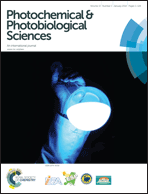
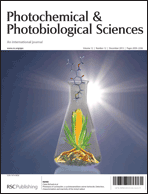
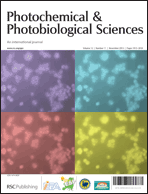 The front cover this month features work by M. Manikandan and Hui-Fen Wu from Kaohsiung, Taiwan. In their work they look at the differential photoresponse of acridine orange (AO) with live and dead cancer cells in fluorescence spectroscopy.
The front cover this month features work by M. Manikandan and Hui-Fen Wu from Kaohsiung, Taiwan. In their work they look at the differential photoresponse of acridine orange (AO) with live and dead cancer cells in fluorescence spectroscopy.